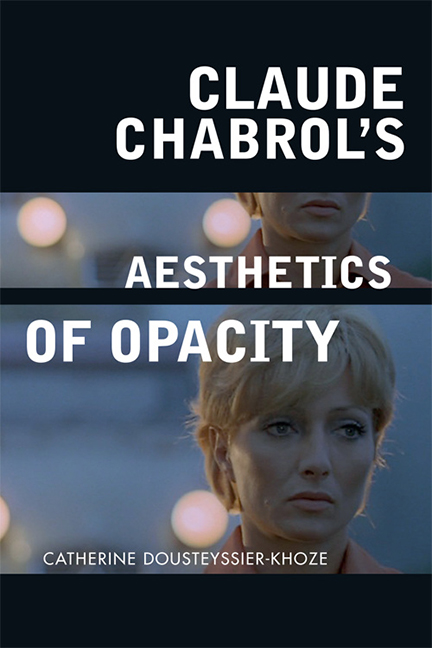Book contents
- Frontmatter
- Contents
- List of Figures
- Acknowledgements
- Dedication
- Introduction
- 1 Contexts and Influences
- 2 Chabrol and Genres
- 3 The Human Beast
- 4 Family Secrets
- 5 Chabrolean Spaces as Heterotopias of Crisis
- 6 Through the Looking Glass: Chabrol’s Mirrors and the ‘Crystal-image’
- Conclusion: Towards an Aesthetics of Visual Opacity
- Filmography
- Bibliography
- Index
6 - Through the Looking Glass: Chabrol’s Mirrors and the ‘Crystal-image’
Published online by Cambridge University Press: 10 November 2020
- Frontmatter
- Contents
- List of Figures
- Acknowledgements
- Dedication
- Introduction
- 1 Contexts and Influences
- 2 Chabrol and Genres
- 3 The Human Beast
- 4 Family Secrets
- 5 Chabrolean Spaces as Heterotopias of Crisis
- 6 Through the Looking Glass: Chabrol’s Mirrors and the ‘Crystal-image’
- Conclusion: Towards an Aesthetics of Visual Opacity
- Filmography
- Bibliography
- Index
Summary
Chabrol's films are often very reflexive: doubles, games of symmetries, mirrors, embedded narratives and images, and intratextual winks abound. These reflexive constructs can affect a given film to a larger or lesser extent but, as a whole, they play a pivotal role in Chabrol's mosaic, in particular with respect to his exploration of the limits between the actual and the illusory, and as a means to achieve a ‘traversée des apparences’. As Dällenbach pointed out: ‘a mise en abyme is any aspect enclosed within a work that shows a similarity with the work that contains it’. According to him, ‘its essential property is that it brings out the meaning and form of the work’. Chabrol is particularly keen on such games and riddles that allow him to distance himself, sometimes in a very subtle way, from a realistic mode of representation: like Magritte, Chabrol excelled at subverting the representation of reality by making it look oneiric and uncanny.
Incipit-mises en abyme and Lack of Closure: The Chabrolean Spiral
Critics have often commented on the open-endedness of Chabrol's film endings, about their lack of closure and the ways in which they seem to ask more questions than they answer. But not much attention has been paid to their relationship with the Chabrolean incipits, that sometimes contain in seed, embedded within their own structure, the entire film.
This spiral often requires a second viewing in order to be identified as such; it functions as a mini-story containing visual metaphors for the key themes (entrapment, for instance). Chabrol confessed his passion for this type of reflexive trick during the making of La Demoiselle d’honneur: ‘Ce qui serait idéal, c’est que chaque plan du film contienne tout le film (mais ça n’arrive jamais)’ [‘The ideal would be for each shot of a film to contain within itself the whole film (but it never happens)’]. The relationships between the beginnings and the endings are often complex in Chabrol's films: the settings can look very similar or even identical but there are small variations that yield meaning (and, indeed, ‘repetition with a difference’ is one of the definitions of parody), as we shall see, for instance, in L’Enfer.
- Type
- Chapter
- Information
- Claude Chabrol's Aesthetics of Opacity , pp. 142 - 160Publisher: Edinburgh University PressPrint publication year: 2017



